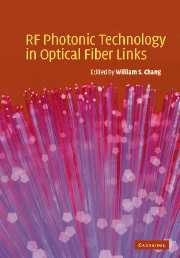Book contents
- Frontmatter
- Contents
- List of contributors
- Introduction and preface
- 1 Figures of merit and performance analysis of photonic microwave links
- 2 RF subcarrier links in local access networks
- 3 Analog modulation of semiconductor lasers
- 4 LiNbO3 external modulators and their use in high performance analog links
- 5 Broadband traveling wave modulators in LiNb03
- 6 Multiple quantum well electroabsorption modulators for RF photonic links
- 7 Polymer modulators for RF photonics
- 8 Photodiodes for high performance analog links
- 9 Opto-electronic oscillators
- 10 Photonic link techniques for microwave frequency conversion
- 11 Antenna-coupled millimeter-wave electro-optical modulators
- 12 System design and performance of wideband photonic phased array antennas
- Index
- References
1 - Figures of merit and performance analysis of photonic microwave links
Published online by Cambridge University Press: 06 July 2010
- Frontmatter
- Contents
- List of contributors
- Introduction and preface
- 1 Figures of merit and performance analysis of photonic microwave links
- 2 RF subcarrier links in local access networks
- 3 Analog modulation of semiconductor lasers
- 4 LiNbO3 external modulators and their use in high performance analog links
- 5 Broadband traveling wave modulators in LiNb03
- 6 Multiple quantum well electroabsorption modulators for RF photonic links
- 7 Polymer modulators for RF photonics
- 8 Photodiodes for high performance analog links
- 9 Opto-electronic oscillators
- 10 Photonic link techniques for microwave frequency conversion
- 11 Antenna-coupled millimeter-wave electro-optical modulators
- 12 System design and performance of wideband photonic phased array antennas
- Index
- References
Summary
Introduction
Microwave links serve important communication, signal processing and radar functions in many commerical and military applications. However, the attenuation of microwave RF signals in cables and waveguides increases rapidly as the frequency of the signal increases, and it is specially high in the millimeter wave range. Optical fibers offer the potential for avoiding these limitations for the transmission of RF signals.
Photonic microwave links employ optical carriers that are intensity modulated by the microwave signals and transmitted or distributed to optical receivers via optical fibers. Since the optical loss for fibers is very low, the distance for photonic transmission and distribution of microwaves can be very long. When the modulation of an optical carrier is detected at a receiver, the RF signal is regenerated. Figure 1.1 illustrates the basic components of a simple photonic microwave link.
Since the objective of a photonic microwave link is to reproduce the RF signal at the receiver, the link can convey a wide variety of signal formats. In some applications the RF signal is an unmodulated carrier – as for example in the distribution of local oscillator signals in a radar or communication system. In other applications the RF signal consists of a carrier modulated with an analog or digital signal.
- Type
- Chapter
- Information
- RF Photonic Technology in Optical Fiber Links , pp. 1 - 34Publisher: Cambridge University PressPrint publication year: 2002
References
- 15
- Cited by



